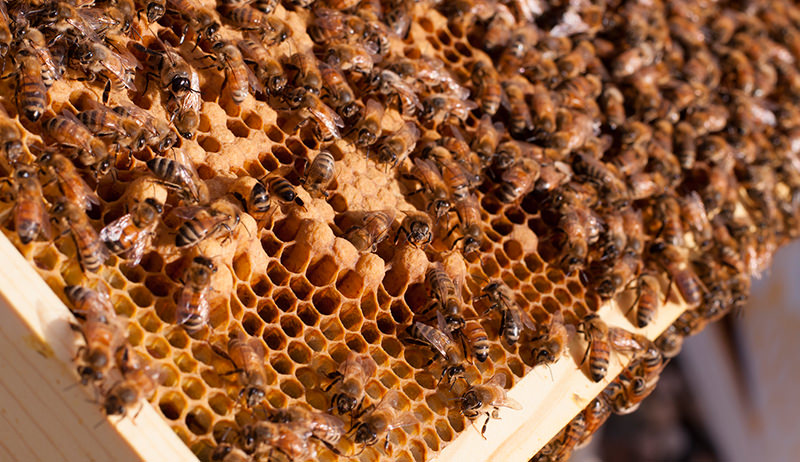
Honeybees live and die by their queen. It may sound a tad melodramatic, but their loyalty is strong. In very certain terms, they can’t survive without her. The queen is the mother of all of the bees in a given hive; the workers are her daughters, and the drones are her sons. She is responsible for laying all of the fertile eggs in a hive, thereby insuring that there are future generations to continue. When a “generation” of a honeybee only lasts about three to give weeks in the peak of summer, there’s a very narrow window of time for beekeepers to rectify any problems with her laying or viability.
But workers have a very special power, one that even the queen doesn’t possess. In the event of a queenless hive, female worker bees can produce a new queen, as long as they have an egg or a young larva to work with. Knowing this fact is important when encountering queen cells, the little pods where queen bee larvae develop. Specific clues, such as the queen cell’s location, the time of year and the overall health of the hive, can help you piece together the reason for the cell and inform you on what to do next.
Let’s take a look at the three main types of queen cells and why you need to know about them.
1. Swarm Cells
Of the three kinds of queen cells discussed in this article, swarm cells are the most common. All healthy hives will want to swarm—procreation is the mark of strength and vigor after all. The clues that let you know a queen cell is specifically for swarming is typically a combination of time of year and location of the cell in the hive.
Swarm cells are often visible in strong hives in mid-spring. In the Southeast, mid-April to mid-May is peak swarm season. It will differ slightly depending on your region, the warms of the spring in a given year the amount of forage (flowering plants and nectar) that is available, but many beekeepers in the continental U.S. experience roughly the same timetable.
Swarm cells are most commonly located on the bottoms of brood frames. They are usually the quintessential peanut shape, but experience tells us that swarm cells can be a bit smaller than supercedure or emergency queen cells. You might mistake them for large drone cells or “play” practice cells. Using your beekeeping detective skills of reading the season and knowing your hive will clue you into their intentions. Usually, if you see a swarm cell, the bees are already making preparations to swarm, and removing them will not always keep them from swarming.
2. Supercedure Cells
Supercedure cells occur when the collective hive of bees decides that their current queen is not quite up to snuff. She may be old and failing, she may not be strong to begin with, or there may be some other wise reason the bees have concluded that she is unfit and decide to replace her. Fortunately, this is an area where it pays to be hands off and trust the bees. “Replacement” of a queen bee by supercedure does not necessarily mean the old queen is killed. She may live harmoniously beside her superceding daughter queen.
As a beekeeper, you’ll usually notice supercedure cells located in the center of brood frames. Your clues to supercedure lie in the current queen and the health and state of the colony at the time of the superceding. Are they a strong colony? Are they fighting many pests and doing so successfully? Is the population low? What is the queen’s brood pattern and behavior like? Supercedure is a fascinating process, but monitor carefully in case something goes awry. With a new virgin queen that must still mate, and perhaps a failing older queen, you may be required to intervene with a new queen if the supercedure doesn’t go according to plan.
3. Emergency Cells
Emergency queen cells are just that: the workers’ attempt to make a replacement queen in a hurry. A hive can be “queenless” for a number of reasons. The old queen may have been crushed or died of other causes; a queen may get lost during inspections and not make her way back to the hive; or a virgin queen may not make it home from her virgin flight. Whatever the reason, the workers know rather quickly when something is wrong, and they spring into action.
Because of the nature of these cells, they are not perfect or ideal. They’re a last ditch effort to save the colony. As such, the cells may be located absolutely anywhere on the frames that the workers were able to find young enough eggs or brood to try to convert to a queen.
To the beekeeper, emergency cells may appear wonky: small, misshapen, only slightly larger than a typical cell. It is critical to keep a very close eye on a queenless hive. Any number of things can go wrong if you don’t intervene, and it’s not worth it in this case to lose an otherwise healthy hive to “letting nature take its course.” This is why we’re beekeepers. Have a fellow beek or supplier on call with a replacement queen at the ready if you see they need it.
Queens are absolutely fascinating honeybees, spending almost the entirety of their lives in the dark depths of the hive, but conducting one of the most critical roles to honeybee survival. Although there’s only one queen, treat all of your bees like the queens they are (or could have been) by being a hands-on, eyes-on beekeeper and knowing your way around queen cells.




